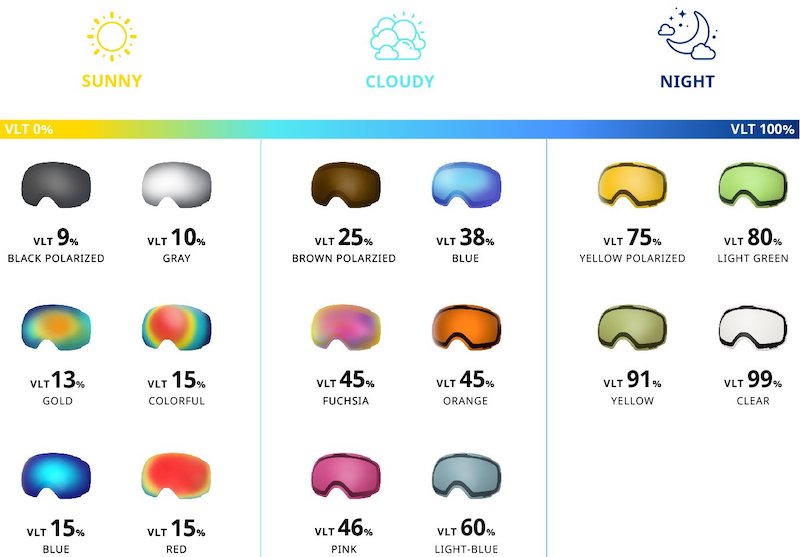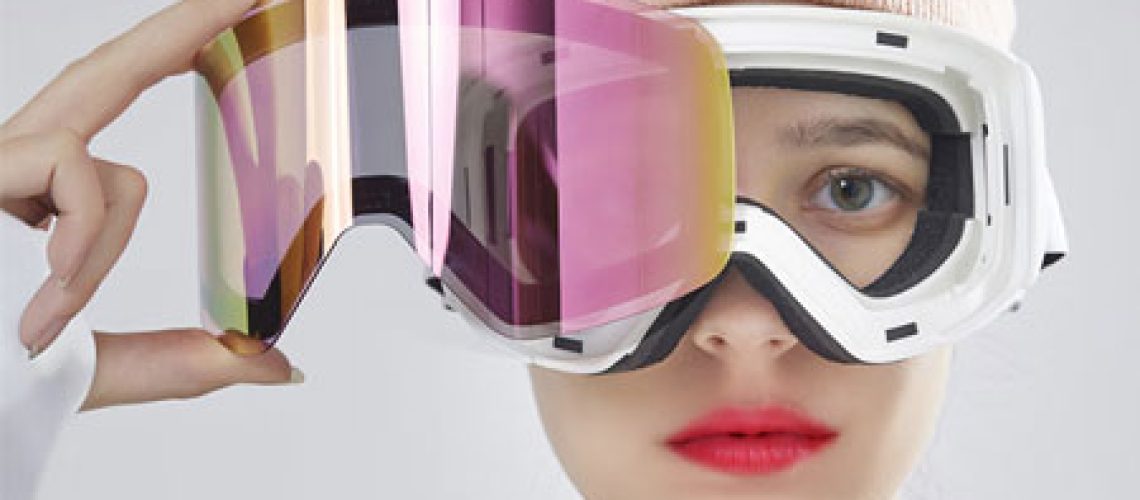As you navigate the web in search of the perfect pair of snow goggles, you’ll inevitably encounter unfamiliar terms. Among the less common acronyms that frequently pop up is VLT. But what exactly does VLT stand for in the context of snow goggles?
WHAT IS VLT?
The amount of light that passes through the lens of goggles is referred to as Visible Light Transmission (VLT).
VLT is expressed as a percentage that indicates the amount of light allowed to pass through the lens, ranging from 0% to 100%. A lower VLT percentage signifies darker lenses, while a higher VLT percentage indicates lighter lenses (or more transparent). The key takeaway is to understand that high VLT lenses are suitable for low-light conditions, while low VLT lenses are more appropriate for sunny days.
HOW TO CHOOSE VLT?
When selecting ski goggles with VLT (Visible Light Transmission), consider the following factors:
- Usage Environment: Different light conditions require goggles with different VLT values. For example, for sunny conditions, it is recommended to use lenses with a VLT of 5%-20%, for cloudy or overcast days use lenses with a VLT of 25%-55%, and for snowy weather, lenses with a VLT of 60%-90% are needed. If you are skiing at night, lenses with a VLT of 65%-95% would be more suitable.
- Lens Color: The color of the lens is related to the VLT value, with darker colors typically having lower light transmission. Dark-colored lenses such as black and dark gray are suitable for sunny weather, while pastel colors like orange and green are suitable for cloudy or overcast days.
- Interchangeable Lens Technology: If you often ski in varying light conditions, choosing goggles with interchangeable lenses is more convenient. Some brands offer lenses with both high and low light transmission to adapt to different weather situations.
- Photochromic Technology: Some ski goggles use photochromic lenses that automatically adjust their color based on the intensity of ultraviolet light. The VLT of these lenses typically varies between 15%-70%, but their performance may not be ideal in conditions with frequent light changes or on overcast days.
- Personal Preference: If you are unsure of your needs or want a single pair of goggles for various weather conditions, you can choose lenses with a VLT between 15%-30%, which are suitable for use in cloudy to sunny conditions.
- Additional Features: Modern ski goggles may also have additional features such as UV protection, polarization, mirror coating, double lens technology, and anti-fog coating, which can be considered when making a purchase.
- Lens Shape: Ski goggles typically have cylindrical and spherical lenses. Spherical lenses offer better vision and anti-glare performance, while cylindrical lenses are more budget-friendly.
- Asian Fit: For those in Asia, choosing ski goggles designed for Asian facial features (Asian Fit) can provide a better fit and comfort.
- Helmet Compatibility: Ensure that the ski goggles are compatible with your helmet, with no large gaps, and that they do not affect the fit and comfort of the goggles when the helmet is worn.
- Over Glasses: If you wear glasses, you can choose OTG (Over The Glasses) style ski goggles, which are designed to accommodate glasses and reduce pressure.
Taking these factors into account can help you select the right VLT ski goggles for your needs
If you find it troublesome, please contact us, we will provide you with the best service and the most cost-effective customized products!
What is the function of VLT?
VLT, or Visible Light Transmission, serves several important functions, especially in the context of ski goggles and other types of eyewear designed for outdoor activities:
- Light Control: VLT helps control the amount of light that reaches the eyes. On bright, sunny days, a lower VLT (e.g., 5-20%) is preferred to reduce glare and prevent eye strain. On overcast days or in low-light conditions, a higher VLT (e.g., 60-90%) allows more light to pass through, improving visibility.
- Vision Protection: By regulating the amount of light that enters the eye, VLT helps protect the eyes from harmful UV rays and excessive brightness, which can cause snow blindness or other forms of eye damage, especially in reflective environments like snow or water.
- Visual Comfort: Different VLT percentages can enhance visual comfort by reducing eye fatigue. For instance, on very bright days, a lower VLT can make the environment appear less harsh to the eyes, while on cloudy days, a higher VLT can help the eyes see more clearly without straining.
- Adaptability: Ski goggles and other outdoor eyewear often come with interchangeable lenses with different VLT percentages, allowing users to adapt to changing light conditions throughout the day or in different weather conditions.
- Contrast Enhancement: Some lenses with specific VLT levels are designed to enhance contrast, which can be particularly helpful in sports like skiing or snowboarding where seeing details on the snow is crucial for safety and performance.
- Photochromic Lenses: Lenses with photochromic technology automatically adjust their VLT based on the light conditions, providing a dynamic solution for varying light environments without the need for manual lens changes.
- Aesthetic Appeal: The VLT level can also affect the aesthetic appeal of the lenses, as different colors and tints can be associated with different VLT levels, allowing for personal style preferences in addition to functional considerations.
- Safety: In certain sports or work environments, the appropriate VLT can be crucial for safety. For example, in alpine skiing or mountaineering, a lens that offers good VLT for bright sunlight is essential to avoid disorientation and potential accidents.
Overall, VLT is an important consideration when selecting eyewear for outdoor activities, ensuring not only visual clarity and comfort but also eye safety and performance in various lighting conditions.
Tips From The Pros
In summary, understanding VLT and the importance of having different lens tints to adapt to the ever-changing conditions on the mountain is crucial, and it can truly change the game. It’s best to have at least two pairs of lenses on hand to switch out when necessary.
With MPM goggles, you’ll get a lens that’s perfect for sunny or variable conditions right out of the box.we are a professional ski goggle customization team.







